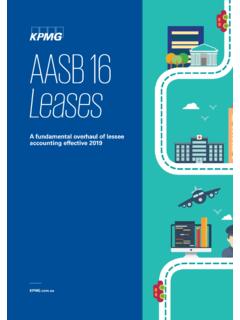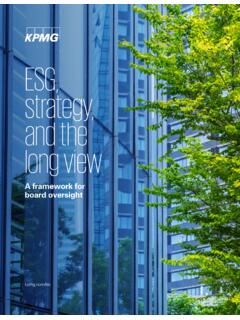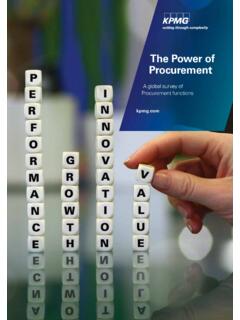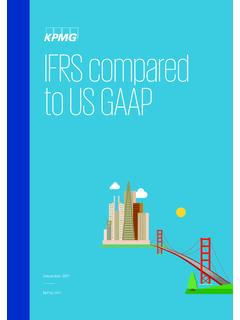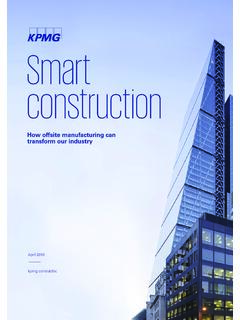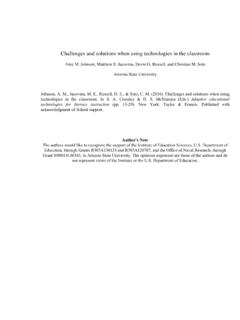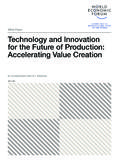Transcription of Emerging trends and technologies in the automotive sector ...
1 KPMG IN INDIA AND ACMA INITIATIVEE merging trends and technologies in the automotive sectorSupply chain challengesand opportunities 1234567 Prepared for ACMA s National Conference on driving affordable and accessible technology sustain logo belongs to ACMA s Sustainable Technology Development from KPMG01020304070918 Message from ACMAT able of contentsExecutive summaryIndian automotive industryRegulatory landscapeTechnologies and trends that could drive the industrySupply chain capacity12345671 Message from KPMGThe automotive industry is a significant contributor to India s GDP. Though the industry has been witnessing subdued growth, the long-term outlook for the sector remains positive. India has become a coveted market not only for global vehicle manufacturers but also for component suppliers. Many vehicle manufacturers today consider India as a key part of their global strategy. Interestingly, this potential is not limited only to the domestic market.
2 automotive companies, both Indian and international, OEMs or component suppliers alike, have made their presence felt on the global stage. India exported ~ million vehicles in 2014-15. The potential is immense and growth opportunities abound. However, to realise its potential, the industry has to be mindful of the challenges that the global automotive sector is facing and adapt to the changing dynamic environment. Stringent emission and safety norms are playing an increasingly important role globally. In the recent past, the government has focussed on tighter emission norms to regulate air pollutants from vehicles and is promoting green vehicles. Of late, safety has also been attracting governmental attention. Evolving technologies and trends in connectivity, lightweighting, electronics, etc. have only added to these complexities. automotive supply chains may have to deal with the complexities that arise out of these changes.
3 Vehicle manufacturers, along with their suppliers, need to evaluate ways to address these issues and develop technologies which are affordable and report provides deeper insight on these trends that are shaping the market and the challenges they pose to the Indian automotive industry. It also outlines the current state of the industry and indicates the way forward as well as the opportunities that could exist for suppliers in the near SinghPartner and Head automotive sector KPMG in IndiaThe automotive Component Manufacturers Association of India (ACMA) is the apex body furthering the cause of the manufacturers of automotive parts and accessories in India and simultaneously, been the bedrock that has enabled the Indian automobile industry to take giant strides in producing vehicles of international repute. Today the turnover of the auto component industry is INR2340 billion ( billion) for the period April 2014 to March 2015, registering a growth of 11 per cent over the previous year and a Compounded Annual Growth Rate (CAGR)of 11 per cent over the last six auto component industry in India is expected to scale up to INR6347 billion (USD100 billion) in turnover by 2020 with exports to grow the in range of INR2221-2539 billion (USD35-40 billion).
4 To keep up this growth the industry has to overcome challenges in technology, high cost of capital, capacity utilisation, infrastructure, input costs, government policies and human capital. A focus is also required on investments in technology and collaboration with the supply chain, apart from other of the major challenges for the industry is to build R&D competence and an , ACMA has been engaged with Fraunhofer, MIT, CMERI and other research is now encouraging R&D by giving a 15 per cent reduction of rate of income tax on royalty and fees for technical is the time to invest in higher level involvement by industry players in electronics, safety, making key functionalities accessible and reduction in development and production costs will make technology more affordable over a period of this connection ACMA STDC (Sustainable Technology Development Committee) took the initiative through this conference to provide an industry perspective on Emerging affordable and accessible technologies in the automotive sector .
5 It will cover lightweighting, electrification of powertrains and improving the safety and fuel efficiency of vehicles. It will also touch upon how connectivity and electronics will emerge as differentiators in new age vehicles. In addition, it will involve discussions on the impact of the technology and regulatory developments on Emerging business models of vehicle manufacturers and auto component from ACMAV innie MehtaDirector GeneralACMA23 Executive summaryGlobal automotive Original Equipment Manufacturers (OEMs) and suppliers recognise India as a key market sector is witnessing significant changes in line with the global industry. Fuel efficiency (lowering the cost of operating a vehicle) has always been a key factor for Indian customers. However, of late, emissions and safety have also assumed greater importance, in line with global trends . The Indian government is considering bringing in stringent safety, emissions and fuel efficiency related OEMs have been working on various technologies such as lightweighting, electrification of powertrains and safety features (Anti-lock Braking System (ABS), Electronic Brakeforce Distribution (EBD) etc.)
6 These are increasingly finding their way into Indian vehicles as well. While these developments do pose a host of challenges, they also open a lot of interesting opportunities for the Indian automotive sector . On electrification of powertrain, lack of volumes and technology advancements have left the Indian electric vehicle industry lagging behind China, the United States, Japan, etc. While the National Electric Mobility Mission Plan (NEMMP) 2020 was launched by the government to provide demand side incentives with an R&D focus, Faster Adoption and Manufacturing of (Hybrid and) Electric vehicles (FAME India) to increase the adoption of electric and hybrid vehicles in India. These moves are a positive sign for an industry that is still in its nascent stage with an underdeveloped supply is another area where limited progress has been made by the Indian automotive companies. While Tier 1 suppliers have been working closely with OEMs on this, the challenge is to bring this capability to Tier 2 and 3 levels as in India is in its early stages of growth.
7 The segment is closely followed by the development in electronics and advancement in communication technology. The infotainment segment is largely based on consumer lifestyle. Prominence of IT industry in the country is a boon to the telematics industry. Growing demand in telematics and infotainment has resulted in the need of having a well-defined telematics supply chain supported by adequate infrastructure for it to be widely accepted and adopted. The penetration of electronics in the automotive industry is increasing significantly. Considering the growing importance of electronics in cars, developing less expensive electronics architecture may expedite the demand for electronics and enable sophisticated functionalities. Indian software firms, can play a pivotal role by forming effective partnerships with industry stakeholders to create a mark paper discusses these Emerging trends in the automotive industry with specific relevance to India and evaluates the impact of these trends on the automotive supply chain.
8 It concludes with a view on the existing supply chain precision and the way The Indian automotive industry has seen significant evolution in the last three to four decades. In the 1970 s, India was a closed market with a restrictive regulatory environment and growth was limited by supply, outdated auto models, high duties and sales taxes. Post liberalisation, the automotive sector was de-licenced with automatic approval for Foreign Direct Investment (FDI) up to 100 per cent equity. This period also saw an entry of the key automotive OEMs and suppliers into the Indian market through organic or inorganic routes. Today, Indian consumers have a gust of choices and automotive companies are designing vehicles from ground up and taking them to other markets. The automotive industry today contributes approximately 22 per cent to the country s manufacturing Gross Domestic Product (GDP)1. In recent years, India has witnessed increasing investments in R&D and geographic expansion from global automotive manufacturers.
9 Considering the automotive industry ranked sixth in attracting FDI equity, with a cumulative inflow of approximately INR681 billion from April 2000 - April 20152, successful formulation and changes in policies have also been made by the government to support the 2014-15, the industry registered a growth of per cent over the same period last year by producing 23 million vehicles3. While the domestic sales of passenger vehicles, three-wheeler and two-wheeler in April 2014 grew, commercial vehicles registered a negative growth, which was credited to muted economic activity. Exports across almost all vehicle segments showed a positive growth during the same automotive industrySource: Society of Indian Automobile Manufacturers and *KPMG in India analysis, 2015 (Calculated values)1. Factsheet on Foreign Direct Investment (FDI), accessed April 20153. and export trend, 2009-10 to 2014-154 While the Indian automotive industry continues to evolve with increasing customer expectations from products, price sensitivity, shorter product life cycles, frequent change in product ownership and focus on safety and entertainment features, the industry is also witnessing significant regulatory growth in the automotive industry is expected to provide several opportunities in both rural and urban markets to industry participants, since the Indian industry has robust domestic sales in key segments.
10 Emerging preference for SUVs and MPVs is likely to drive the introduction of new models. Commercial Vehicles is expected to grow this year on account of improved economy performance. While two wheelers will continue to remain the mainstay of the industry accounting for almost 70-75 per cent of the automotive industry volumes. While two wheelers will continue to remain mainstay of the industry accounting for 75 per cent of the industry volume4. However, the industry ecosystem faces several roadblocks such as land acquisition procedures, tax complexity, infrastructure constraints, changing emission and safety norms, etc. On the other hand, its demand-side faces challenges on price sensitivity and introduction of increasing number of vehicle models and variants, which has made India a tough market to compete. This fierce competition has impacted the supply side by increasing the pressure on costs. There are high product design and modification costs involved in the supply side as well, which is influencing the supply chain.


